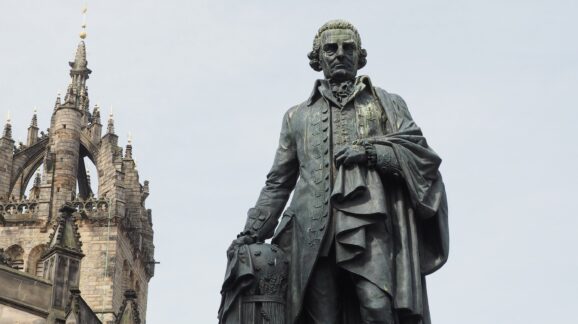Adam Smith and the wealth of America

Photo Credit: Getty
2023 is the 300th anniversary of Adam Smith’s birth. This post is part of a series highlighting aspects of Smith’s thought that continue to influence liberal thought in general, and CEI’s work in particular. Part 1 on the real Adam Smith is here. Part 2 on Smith and American bureaucracy is here. Part 3 on Smith’s concepts of love and loveliness is here. Part 4 on how some scholars have misunderstood Smith is here.
Adam Smith’s magnum opus, The Wealth of Nations, was published during the same year that America gained its independence as a nation. Perhaps no other country in the world benefited more from harnessing the ideas on capitalism advanced in Smith’s work. America’s free-market system continues to flourish today as a testament to Smith’s ideas.
One of the great advantages of America’s free-market economy is illustrated by Adam Smith’s metaphor of the “invisible hand.” In Smith’s view, the spontaneous interactions of everyone in a market system tend toward the optimal use of available resources, producing benefits across society, despite those benefits not being the goal of any individual or supervising authority.
Also, while individuals are primarily guided by their own self-interest in making economic decisions, Smith did not necessarily view them as “selfish” or “greedy,” because they’re collaborating with other free individuals for mutual gain. In a voluntary market, both buyers and sellers are better off when they do business together.
This interdependence encourages producers to supply the market with products that are essential to consumer wellbeing, while simultaneously financing their own enterprise. A component of this is the nature of “arms-length transactions.” These are commercial engagements between two or more dissimilar parties which agree to do business. Their collaboration is driven purely by financial self-interest and an equal moral agency to accept or reject offered terms. To ground this in the human element, even though a producer may care first and foremost about his profit-margin, he also cares about how his products are being consumed and enjoyed by his customers.
Smith’s revolutionary notion of the division of labor—separating workers’ daily responsibilities based on their relative specialties—has multiplied productivity and thus overall economic growth in industrial societies more than any other factor. Less government involvement in the economic affairs of a country by central planners enables more leverage on production from dispersed private actors. Smith understood that a healthy combination of private competition, legal protection for property rights, and rational self-interest among market participants provides a roadmap toward economic prosperity.
Smith’s ideas were inspirational to succeeding generations of economic thinkers. Those who carried up his mantle were known as mainline economists, encompassing the fundamental tenets of economics research. Mainline economics as a body of scholarship actually predated Smith, going as far back as St. Thomas Aquinas in the 13th Century. Prominent disciples of Smith include Fredrich Hayek, Ronald Coase, James Buchanan, Vernon Smith, and Elinor Ostrom, whose Nobel-winning contributions were cherished by the Neoclassical school of the 20th century.
These individuals were on the forefront of applying sound economic theories and empirical data toward resolving real-world problems. Such ideals have been championed by current-day research and advocacy organizations like the Mercatus Center and the Competitive Enterprise Institute, among many others.
In bridging the gap between theory and public policy, mainline economists have sought to resolve a host of ongoing conundrums, such as “Why are some societies fabulously wealthy while others are miserably poor?” and “How can we as humans live together peacefully and prosperously?” (The latter question was put that way in the book Mainline Economics: Six Nobel Lectures in the Tradition of Adam Smith.)
Nudged along by Smith’s ideas on wealth, these researchers have found that economic growth in society is largely dependent upon the standard of living for a majority of its citizens. Economic growth produces a diverse array of opportunities for working and middle classes, leading to a greater propensity for participation in the market and access to financial mobility. Smith argued that consistent human exchange of goods, services, and ideas is what drives the economy. Mainline economists focus their efforts on explaining the societal benefits of these exchange-based relationships, from both market and non-market collaborations.
Adam Smith’s invaluable contributions to the study of economics continue to ring loudly 300 years after his birth. He provided the theoretical framework for why a free, market-driven economy is able to produce both expanding prosperity and a flourishing civil society, all without a central planner. American economists today would be wise to remember and pay their respects to that legacy.